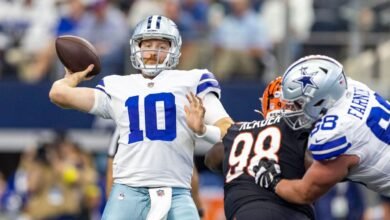Tyson-Paul — 58-year-old Tyson is still changing the game

Having covered Mike Tyson since his most famously unsanctioned bout — a predawn TKO of Mitch “Blood” Green at an after-hours clothing boutique in Harlem, New York, on Aug. 23, 1988 — and having spent the past three-plus years anatomizing his ascent as a biographer, I’ve been getting a lot of calls, all posing the same basic question:
“Is this thing real?”
It’s real enough, what a spokesperson from the Texas Commission of Licensing and Regulation assures me is “a professional, sanctioned bout” with Jake Paul, live from AT&T Stadium, Friday on Netflix. Still, the cynicism comes as no surprise. It’s boxing, after all, where “real” fights can be effectively scripted (and often are) in the matchmaking. Also, it’s Tyson, for whom state-run boxing bureaucracies have always been compliant. In this case, Texas signed off on the Tyson-Paul request for 14-ounce gloves (instead of the heavyweight standard 10-ounces) and eight two-minute rounds (instead of the standard three minutes across 10 or 12 rounds for men).
What’s more, don’t expect the state to enforce its prohibition of marijuana against Tyson — who, of course, swore he quit weed in preparation for this bout — with the same zeal it did against, say, Keyshawn Davis, a rising star who forfeited a win after testing positive last year in Rosenberg, Texas.
But all that misses the point. Actually, it misses them both. First, Tyson’s is the greatest comeback I’ve ever seen, and likely ever will. By the time the city editor dispatched me uptown, Tyson was already in the throes of his first public crack up. In itself, that’s not unusual. Most fighters seem as though they’re born to be destroyed. They tend to get used up: physically, neurologically, spiritually and of course, financially. Tyson was always an extreme case, though.
At 22, his doom already seemed a lock.
In 2012, during previews for his one-man show, “Undisputed Truth,” I asked him if he ever imagined reaching his then-age of 45. “I couldn’t have believed that,” he said.
I’d venture an educated guess that, across the years, I’ve written more nasty stuff about Tyson than, well, anyone — much of it justified, some of it not, some of it shameful. But those same years also taught me that it’s better to judge fighters, not by their records, but by what they’ve survived. In Tyson’s case, that includes most of the urban plagues’ endemic to his Brownsville neighborhood in Brooklyn, New York, in the 1970s, including violence and fatherlessness, but also the untimely death of a mother.
Incarceration (juvenile and adult). Molestation. Booze. Coke. Boxing. Bankruptcy. Don King. The death of a child.
And perhaps, most treacherous of all, fame. Tyson got a lethal dose of a very particular American strain of it whose victims include Elvis, Marilyn and Tupac.
But here he is: a tennis dad with a Goldendoodle. It’s impossible to ignore that this second ascent coincides with the years of his now 15-year marriage to the former Kiki Spicer. In many respects, she’s the architect of his comeback, and not coincidentally, the writer of that same one-man show. It’s a peculiar proposition: trying to reconcile the old Tyson with this outwardly happy, domesticated and prosperous one. But that brings me, at last, to the second point: At 58, not only has Tyson become an avatar of bro culture, but remains the most lucrative persona in the history of combat sports — or any other sport for that matter. Wherever he’s been, whatever he’s done, Tyson remains the undisputed champion of the male demographic.
So understand this business with Jake Paul means less as a fight than it does as a long-running media story First, it was cable — a full decade before Tony Soprano, Tyson was HBO’s leading man, a “walking billboard” for a still emerging network, as one executive called him. Then it was pay-per-view — an entire business that grew around Tyson. You want to talk about fights that are fixed in the matchmaking? Start with Tyson vs. Peter McNeeley in 1995. It did 1.55 million buys. Just four months later, Fox — then another fledgling network looking for some heat — aired Tyson vs. Buster Mathis Jr. Though it offered even less suspense than the McNeeley fight, 43 million people tuned in. In other words, now that the game is live streaming, it’s no surprise Netflix wants in.
It’s time to stop dismissing Jake Paul as a YouTuber, an impresario of mere stunts, or even a former Disney star who’s fashioned himself into a passable professional fighter. He’s a better promoter than many of the “purists” who’ve shepherded boxing to its current state. Paul is nothing if not purposeful. His involvement in boxing began long before most people know, as far back as 2016, the fighter Ryan Garcia once told me. And while Paul remains a skilled provocateur — or perhaps, because of it — he understands how to work the media better than anyone I’ve ever seen, at least anyone not named Al Sharpton or Donald Trump.
Now consider where Paul was as a fighter and a promoter. With a 10-1 record, having dropped a split decision to Tyson Fury’s brother, Tommy, he had beaten YouTubers, erstwhile MMA stars and rising professional boxers. But the novelty had worn off. So where does he go?
His pal Tyson.
Is it a hustle? Of course. Anything involving two fighters and a promoter is, to some degree, what wrestling aficionados call “a work.” Whether it’s life or death or a scripted exhibition, they’re trying to sell you something: a thrill, a rating, a PPV buy, or in this case, a Netflix subscription. It’s absurd to think of this as a regular fight, or a high-level one. And yes, it may prove a stinker. But you factor in the gloves, the protagonists’ experience, relative ages and health (27 and 58, with Tyson having canceled the first fight due to a bleeding ulcer in May), and you can see why Netflix cut this deal. If it nauseates the “purists,” then good. Unlike the vast majority of fights you’ll see on broadcast or streaming platforms (my own included), you already know enough about these fighters to have an actual opinion. What’s more, unlike main events in most “real” boxing cards, you don’t know who’s going to win. The oddsmakers have made Paul a favorite, though not a prohibitive one. Hence, you can probably imagine either guy with his hand raised.
That’s what makes a fight.
So, is it real? As real as the billions of dollars at stake in today’s streaming wars. The technology might change, but the dynamics? Not so much. It’s still about buzz and buys. And if Tyson isn’t in his prime, so what? The last time he figured in a power struggle between media companies, he was a lot lower than he is now. It was 1998. He’d been banished from boxing, the pariah who had bitten off a piece of Evander Holyfield’s ear. That’s when Vince McMahon — another expert provocateur — hired him for a stint with the WWE.
McMahon and his “Monday Night Raw” broadcast on USA Network were locked in a war with Ted Turner’s “WCW Monday Nitro” on TNT. Actually, calling it a war might have seemed charitable at the time, as “Nitro” was in the midst of an 84-week winning streak in the ratings.
“I didn’t look at the WWE as a threat,” Eric Bischoff, “Nitro’s” creator, told me.
Then he got the news. Bischoff remembers being at a pay phone. “You’re kidding me,” he said. “No,” he was told. “They signed Tyson.”
Bischoff hadn’t pulled ahead in the ratings by not knowing his target audience. “If you were to create the ultimate wrestling character, it would be based on Mike Tyson’s persona at the time,” he told me. “I mean, that’s the world’s perfect badass right there.”
The 1997 ear bite only helped. The pay phone got quiet for a moment. “I knew it was about to get real serious,” Bischoff said. “I knew Tyson would change the game.” Tyson debuted on “Raw” on Jan. 19, 1998, at the Selland Arena in Fresno, California, and concluded his run on March 29 at WrestleMania XIV at TD Garden in Boston. In two months, Tyson’s persona legitimized two others, that of “Stone Cold” Steve Austin and the evil “Mr. McMahon,” while changing the history of sports entertainment.
“That was the pivot point,” Bischoff said. “The 18-to-49-year-old demographic that I controlled for two years just shifted. … It shifted hard and fast and not for any other reason that it was Tyson and how well they executed the storyline.”
Could anyone have caused that shift but Tyson, I asked.
“No,” he said. “No.”
By 2000, WCW was losing about $80 million a year. In 2001, Turner sold it for pennies on the dollar to his bitter rival, McMahon.
So now you know why Netflix is all in on Tyson-Paul. But the real question isn’t who wins or loses. It’s whether Mike Tyson, Good Guy-Babyface-Hero, can generate the same heat he did as a villain.
Source link



